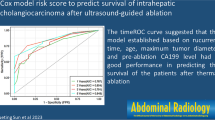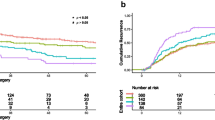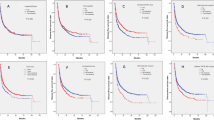Abstract
Objective
To determine whether albumin–bilirubin (ALBI) grade could be used to predict the outcomes of patients with intrahepatic cholangiocarcinoma (ICC) who underwent ultrasound-guided percutaneous microwave ablation (MWA).
Materials and Methods
This retrospective study was approved by the institutional review board, and the requirement for informed consent was waived. We studied 52 treatment-naïve patients with 74 ICC lesions according to the Milan criteria who subsequently underwent MWA from April 2011 to March 2018. Overall survival (OS) and recurrence-free survival (RFS) were compared in groups classified by Child–Pugh score and ALBI grade, which were statistically analyzed with the log-rank test. Cox proportional hazard regression analyses were used to determine the prognostic factors for survival in patients with ICC.
Results
The median follow-up time was 21.2 months (3.2–78.7 months). Seventeen patients died during this period. After MWA, the cumulative 1-, 3-, and 5-year OS rates were 87.4%, 51.4%, and 35.2%, respectively, and the cumulative 1-, 3-, and 5-year RFS rates were 68.9%, 56.9%, and 56.9%, respectively. The major complication rate was 3.8% (2/52). Stratified according to ALBI grade, the cumulative 1-, 3-, and 5-year OS rates were 95.5%, 72.4%, and 72.4% for patients with ALBI grade 1 and 62.5%, 40.6%, and 36.3% for patients with ALBI grade 2, respectively, showing a significant difference (P = 0.006). Multivariate analysis results showed that older age (hazard ratio [HR]: 1.67, 95% confidence interval [CI]: 1.11–2.82; P = 0.002), tumor size ≥ 3 cm in diameter (HR: 11.33, CI: 2.24–34.52; P = 0.021) and ALBI grade (HR: 8.23, CI: 1.58–58.00; P = 0.004) may be predictors of poor OS.
Conclusion
ALBI grade was validated as a significant biomarker for predicting survival in ICC patients within the Milan criteria who underwent MWA.




Similar content being viewed by others
References
Rizvi S, Khan SA, Hallemeier CL, Kelley RK, Gores GJ. Cholangiocarcinoma: evolving concepts and therapeutic strategies. Nat Rev Clin Oncol. 2018;15(2):95–111.
Burt AD, Alves V, Bedossa P, et al. Dataset for the reporting of intrahepatic cholangiocarcinoma, perihilar cholangiocarcinoma and hepatocellular carcinoma: recommendations from the International Collaboration On Cancer Reporting (ICCR). Histopathology. 2018;73:369–85.
Kamarajah SK. Evaluation of the AJCC 8th edition staging system for pathologically versus clinically staged intrahepatic cholangiocarcinoma (iCCA): a time to revisit a dogma? A surveillance, epidemiology, and end results (SEER) analysis. J Gastrointest Cancer. 2018;50:392–9.
Sripa B, Pairojkul C. Cholangiocarcinoma: lessons from Thailand. Curr Opin Gastroenterol. 2008;24(3):349–56.
Xiao J, Zhu J, Liu Z, Wan R, Li Y, Xiao W. Role of surgical treatment for hepatolithiasis-associated intrahepatic cholangiocarcinoma: a retrospective study in a single institution. J Cancer Res Ther. 2017;13(5):756–60.
Kim BJ, Hyung J, Yoo C, et al. Prognostic factors in patients with advanced biliary tract cancer treated with first-line gemcitabine plus cisplatin: retrospective analysis of 740 patients. Cancer Chemother Pharmacol. 2017;80(1):209–15.
Dvorak P, Hoffmann P, Brodak M, et al. Percutaneous radiofrequency and microwave ablation in the treatment of renal tumors: 10 years of experience. Wideochir Inne Tech Maloinwazyjne. 2017;12(4):394–402.
Ferguson CD, Luis CR, Steinke K. Safety and efficacy of microwave ablation for medically inoperable colorectal pulmonary metastases: single-centre experience. J Med Imaging Radiat Oncol. 2017;61(2):243–9.
Mohkam K, Dumont PN, Manichon AF, et al. No-touch multibipolar radiofrequency ablation vs. surgical resection for solitary hepatocellular carcinoma ranging from 2 to 5 cm. J Hepatol. 2018;68:1172–80.
Samimi K, White JK, Brace CL, Varghese T. Monitoring microwave ablation of ex vivo bovine liver using ultrasonic attenuation imaging. Ultrasound Med Biol. 2017;43(7):1441–51.
Cheng Z, Che Y, Yu S, et al. US-guided percutaneous radiofrequency versus microwave ablation for benign thyroid nodules: a prospective multicenter study. Sci Rep. 2017;7(1):9554.
Wang YM, Qian GJ, Xu Y, Wang N, Sheng YH. Efficacy of microwave ablation in treatment of hepatocellular carcinoma within the Milan criteria: a report of 696 cases. Zhonghua Gan Zang Bing Za Zhi. 2017;25(5):344–8.
Sohn W, Kang TW, Choi SK, et al. Effect of oral antiviral treatment on long-term outcomes of radiofrequency ablation therapy for hepatitis B virus-related hepatocellular carcinoma. Oncotarget. 2016;7(30):47794–807.
Kao WY, Chao Y, Chang CC, et al. Prognosis of early-stage hepatocellular carcinoma: the clinical implications of substages of barcelona clinic liver cancer system based on a cohort of 1265 patients. Medicine (Baltimore). 2015;94(43):e1929.
Karaman B, Battal B, Sari S, Verim S. Hepatocellular carcinoma review: current treatment, and evidence-based medicine. World J Gastroenterol. 2014;20(47):18059–60.
Su CW, Chau GY, Hung HH, et al. Impact of steatosis on prognosis of patients with early-stage hepatocellular carcinoma after hepatic resection. Ann Surg Oncol. 2015;22(7):2253–61.
Stasi C, Milani S. Evolving strategies for liver fibrosis staging: non-invasive assessment. World J Gastroenterol. 2017;23(2):191–6.
Wang J, Wang Q, Yu G, She Q, Zhang W, Zhang J. Correlation between liver stiffness measured by shear wave elastography and child–pugh classification. J Ultrasound Med. 2018;37:2191–9.
Suh SW, Choi YS. Predictors of micrometastases in patients with barcelona clinic liver cancer classification b hepatocellular carcinoma. Yonsei Med J. 2017;58(4):737–42.
Lei Q, Zhang Y, Ke C, et al. Value of the albumin-bilirubin score in the evaluation of hepatitis B virus-related acute-on-chronic liver failure, liver cirrhosis, and hepatocellular carcinoma. Exp Ther Med. 2018;15(3):3074–9.
Hiraoka A, Michitaka K, Kumada T, Kudo M. ALBI score as a novel tool in staging and treatment planning for hepatocellular carcinoma: advantage of ALBI grade for universal assessment of hepatic function. Liver Cancer. 2017;6(4):377–9.
Zou H, Yang X, Li QL, Zhou QX, Xiong L, Wen Y. A comparative study of albumin-bilirubin score with child–pugh score, model for end-stage liver disease score and indocyanine green R15 in predicting posthepatectomy liver failure for hepatocellular carcinoma patients. Dig Dis. 2018;36:236–43.
Pinato DJ, Sharma R, Citti C, et al. The albumin-bilirubin grade uncovers the prognostic relationship between hepatic reserve and immune dysfunction in HIV-associated hepatocellular carcinoma. Aliment Pharmacol Ther. 2018;47(1):95–103.
Kao WY, Su CW, Chiou YY, et al. Hepatocellular carcinoma: nomograms based on the albumin–bilirubin grade to assess the outcomes of radiofrequency ablation. Radiology. 2017;285(2):670–80.
Tsilimigras, et al. Prognostic utility of albumin–bilirubin grade for short- and long-term outcomes following hepatic resection for intrahepatic cholangiocarcinoma: a multi-institutional analysis of 706 patients. J Surg Oncol. 2019;120(2):206–13.
Ni, et al. Predictive value of the albumin–bilirubin grade on long-term outcomes of CT-guided percutaneous microwave ablation in intrahepatic cholangiocarcinoma. Int J Hyperth. 2019;36(1):328–36.
Ahmed M. Image-guided tumor ablation: standardization of terminology and reporting criteria—a 10-year update: supplement to the consensus document. J Vasc Interv Radiol. 2014;25(11):1706–8.
Lu MD, Chen JW, Xie XY, et al. Hepatocellular carcinoma: US-guided percutaneous microwave coagulation therapy. Radiology. 2001;221(1):167–72.
Zhang K, Yu J, Yu X, et al. Clinical and survival outcomes of percutaneous microwave ablation for intrahepatic cholangiocarcinoma. Int J Hyperther. 2017:1–6.
Funding
This work was supported by Grants 2017YFC0112000 and 2018ZX10723-204 from the National Key R&D Program of Ministry of Science and Technology of China, Grants 81627803, 81622024, 81971625, and 91859201 from the National Scientific Foundation Committee of China, Grant JQ18021 from the National Scientific Foundation Committee of Beijing, and Fostering Funds of Chinese PLA General Hospital for National Distinguished Young Scholar Science Fund.
Author information
Authors and Affiliations
Corresponding authors
Ethics declarations
Conflict of interest
The authors declare no conflict of interest.
Additional information
Publisher's Note
Springer Nature remains neutral with regard to jurisdictional claims in published maps and institutional affiliations.
Rights and permissions
About this article
Cite this article
Yang, H., Cheng, Z., Han, Z. et al. Assessment of the Outcomes of Intrahepatic Cholangiocarcinoma After Ultrasound-Guided Percutaneous Microwave Ablation Based on Albumin–Bilirubin Grade. Cardiovasc Intervent Radiol 44, 261–270 (2021). https://doi.org/10.1007/s00270-020-02637-9
Received:
Accepted:
Published:
Issue Date:
DOI: https://doi.org/10.1007/s00270-020-02637-9




